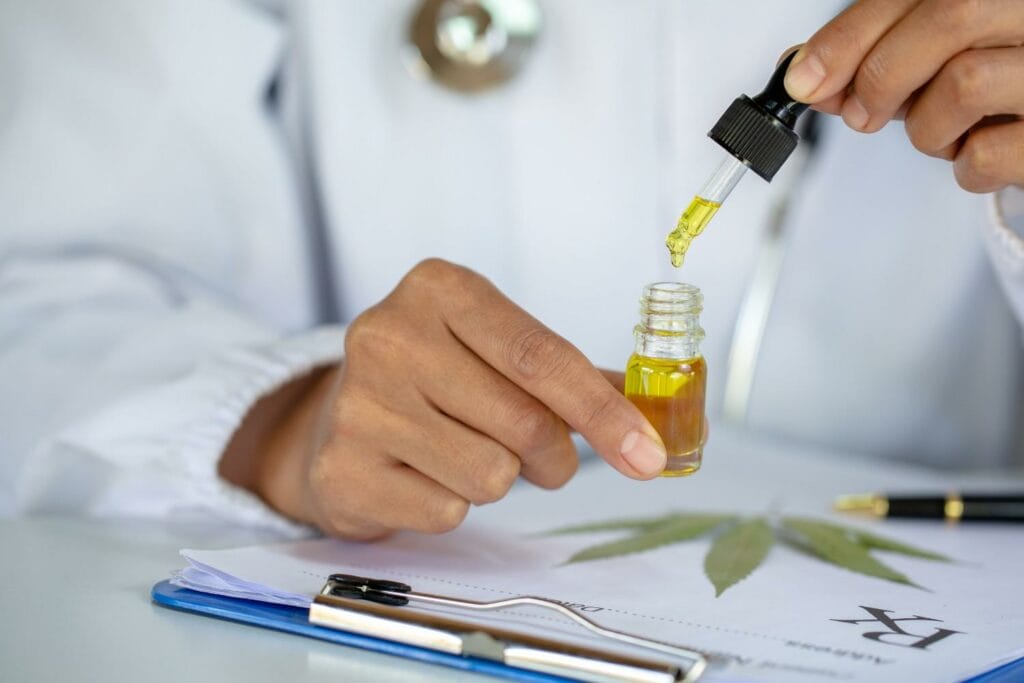Recent research highlights the therapeutic potential of CB2-selective cannabinoids in treating retinal inflammation – a common symptom in eye diseases. This advancement in ophthalmology underscores the broader medical benefits of cannabinoids.
Accompanying the advancement in medical cannabis studies is a selection of products – allowing customers to order weed online. Through online dispensaries in Canada or reputable marijuana dispensaries, patients can seek CB2-focused products delivered to them.
Table of Contents

Key Takeaways:
- Uveitis can cause inflammatory cells to invade and rapidly spread in the eye’s gelatinous center.
- CBD can reduce inflammation by blocking the release of cytokines from immune cells through its interaction with the CB2 receptors.
- A 5 mg/kg dose of CBD provides anti-inflammatory and neuroprotective effects by blocking oxidative stress, p38 MAPK activation, and microglial activation.
What Do You Need to Know About Uveitis?
Uveitis is an inflammation of the uvea – the eye’s middle layer. The type of uveitis depends on which part of the uvea is affected:
- Anterior uveitis (iritis): Inflammation on the outermost side.
- Posterior uveitis (choroiditis): Inflammation on the inside layer.
- Pan-uveitis: Inflammation of both sides of the uvea.
Inflammatory cells invade the gelatinous center of the eye and spread. In most cases, the infection starts suddenly and spreads rapidly. The disease is poorly understood and can lead to blindness.
Uveitis can be due to an infection or other factors. It can also be secondary to other conditions such as microbial infections (syphilis, herpes, TB), eye injuries, autoimmune diseases (e.g., sarcoidosis), chronic inflammatory illnesses (e.g., Crohn’s disease, IBS), certain medications (e.g., Rifabutin), or cancers (e.g., leukemia, lymphoma).
Diagnosis involves a complete eye examination and laboratory tests for underlying conditions. Treatment options may include surgery, antibiotics, antiviral medications, and anti-inflammatory medications like cortisol.
What is CBD?
Cannabidiol (CBD) is a non-psychoactive cannabis compound. It offers multiple therapeutic properties, which makes it a popular choice for medical applications.
Key benefits of CBD include:
- CBD helps reduce inflammation in arthritis and uveitis.
- Provides pain relief without the psychoactive effects associated with THC.
- It has neuroprotective properties, which can be useful in treating conditions like multiple sclerosis and epilepsy.
CBD vs. THC
Tetrahydrocannabinol (THC) is the top psychoactive compound in cannabis responsible for the “high” sensation. Both CBD and THC have therapeutic benefits, but they differ significantly in their effects and applications.
| Aspect | CBD | THC |
| Psychoactivity | Non-psychoactive | Psychoactive, responsible for the “high” sensation |
| Therapeutic Benefits | Anti-inflammatory, analgesic, neuroprotective | Pain relief, anti-nausea, appetite stimulant |
| Target receptors | CB2 receptor | CB1 and CB2, but more on the former |
CBD and Uveitis
CBD can reduce inflammation by inhibiting cytokines from immune cells. It interacts with CB2 receptors on the surface of immune cells, which are present throughout the body. In addition to CB2 interaction, it can inhibit oxidative stress and reduce inflammation through different pathways.
Inhibition of p38 MAPK, Microglial, and ROS
The Medical College of Georgia investigated whether oxidative stress and p38 MAPK activation cause retinal inflammation and microglial activation and whether CBD can reduce inflammation by blocking these processes.
Methods
- Microglial cells from newborn rat retinas were isolated.
- TNF-α levels were measured using ELISA, NO (Nitric oxide) levels with a NO analyzer, and superoxide anion levels via chemiluminescence.
- ROS (Reactive oxygen species) levels were estimated using 2′, 7’-dichlorofluorescin diacetate.
Results
- LPS (lipopolysaccharide) treatment of retinal microglial cells triggered immediate ROS production, p38 MAPK activation, and increased TNF-α production.
- Later phases showed NO, ROS, and p38 MAPK activation peaks and microglial morphological changes. CBD (1 μM) inhibited ROS and p38 MAPK activation, NO, and TNF-α production and maintained cell morphology.
- In LPS-treated rat retinas, macrophage accumulation, microglial activation, ROS, nitrotyrosine levels, p38 MAPK activation, and neuronal apoptosis were observed. 5 mg/kg CBD treatment blocked these effects.
According to these findings, CBD demonstrated protective and inhibitory effects against the inflammatory and oxidative processes induced by LPS treatment in both retinal microglial cells and rat retinas.
Discussion
Oxidative stress drives retinal inflammation and degeneration in uveitis. CBD provides anti-inflammatory and neuroprotective effects by blocking oxidative stress, p38 MAPK activation, and microglial activation.
CBD also reduces oxidative stress, macrophage infiltration, TNF-α production and prevents retinal damage. This suggests that CBD could be a promising new treatment for inflammation-related retinal issues.
Other Studies
Other scientific papers look into CBD and its impact on the CB2 receptors. CBD works as an inverse agonist at the CB2 receptor, which means it binds to the receptor and generates effects opposite to those of an agonist. It also influences several non-cannabinoid receptors and ion channels and operates through receptor-independent pathways to reduce inflammation.
| Study | Year | Result |
| Dalhousie University, Halifax | 2014 | CB2 receptors mediate therapeutic immune responses, which involve reducing transcription factors like AP-1 and inflammatory mediators such as cytokines. CB2 receptors could be promising drug targets for developing new ocular anti-inflammatory agents. |
| University of Aberdeen, UK | 2007 | CB2 agonist JWH-133 has strong anti-inflammatory properties. It inhibits autoreactive T cells and prevents leukocyte movement into inflamed tissue. |
Order Weed Online at Best Online Dispensary Canada
Studies suggest that CB2-rich products could have broad therapeutic potential for treating uveitis. The best marijuana dispensary offers various forms of CBD.
- Oils. Versatile and can be consumed sublingually or mixed with food and beverages.
- Capsules. Convenient for precise dosing. Ideal for those who want a tasteless option.
- Edibles. From THC gummies to other CBD-infused edibles, these are popular for their ease of use and discreet consumption.
| Product | OneStop – Açai Berry Gummies | CBD Tears – Full Spectrum CBD – 1ml |
| Form | Edible | Oil |
| CBD Type | – | Full Spectrum CBD |
| CBD Content | 500mg | 1ml |
| Uses | Inflammation, pain, insomnia | Anxiety relief, skin nourishment, heart health, increased appetite, insomnia relief, nausea relief |
| Application | Oral consumption | Orally, topically, or vaporized |
How to Buy Weed Online in Canada?
If you’re used to buying weed from a physical store, you may think that trying to buy it online might seem complicated. The truth is, buying weed online in Canada is easier than you might think.
- Look for the best online dispensary that offers a wide selection of cannabis products. Check if they have premium strains, marijuana flowers, cannabis concentrates, etc.
- Once you choose a dispensary, browse the products available. You can add THC gummies, edibles, and other marijuana products to your cart. Look for quality product descriptions and customer reviews to find the highest quality marijuana.
- Compare prices to ensure you get the lowest cost for the desired quality. Look out for special deals, free gifts, and loyalty programs for loyal customers.
- Add your desired cannabis items to your cart and proceed to the checkout process. Follow the needed payment instructions provided on the website. Many dispensaries accept Interac e-Transfer for secure payments.
- Most dispensaries use Canada Post for reliable delivery. Check if the dispensary offers shipping insurance and a tracking number for your package. Confirm that your order will be vacuum-sealed for freshness and discretion.
Contact the reliable customer support team for assistance if you have any questions or issues.
Manage Uveitis Inflammation with CB2-Selective Cannabinoids
CB2-selective cannabinoids like CBD can help manage the inflammation caused by uveitis. It reduces inflammation and pain and allows for a less stressful life. The cannabis industry now offers a variety of products available through mail-order marijuana. You can find suitable CBD products at the GrassLife cannabis store.
Frequently Asked Questions
How much CB2-selective cannabinoid must you consume to manage retinal inflammation?
- Starting Dose. A low dose of 2.5 to 5 mg daily to assess tolerance.
- Therapeutic Dose. The most common dose is 20 – 40 mg per dose.
- Maximum Dose. Researchers have determined that a daily dose of 600 mg of CBD appears safe. One study even suggested that doses up to 1,500 mg daily are safe and well-tolerated.
Can THC also contribute to reducing inflammation in uveitis?
THC demonstrates anti-inflammatory properties. In a clinical trial, marijuana led to a 70% reduction in inflammation. The study noted that CB2 cannabinoid receptors experienced the most significant decrease in inflammation.
THC also reduces the production of pro-inflammatory cytokines and inhibits the activation of the brain’s Stat 1 transcription factor, which contributes to the body’s inflammatory response.
Try products with a 1:1 THC to CBD ratio to benefit from both cannabinoids. This combination can more effectively target CB2 receptors for enhanced anti-inflammatory effects.
Can cannabinoids manage pain associated with uveitis?
Yes. Cannabinoids’ analgesic effects work through several mechanisms: they inhibit the release of neurotransmitters and neuropeptides at presynaptic sites, modulate the excitability of postsynaptic neurons, activate the inhibitory pain pathway, and reduce neuroinflammatory signalling.




